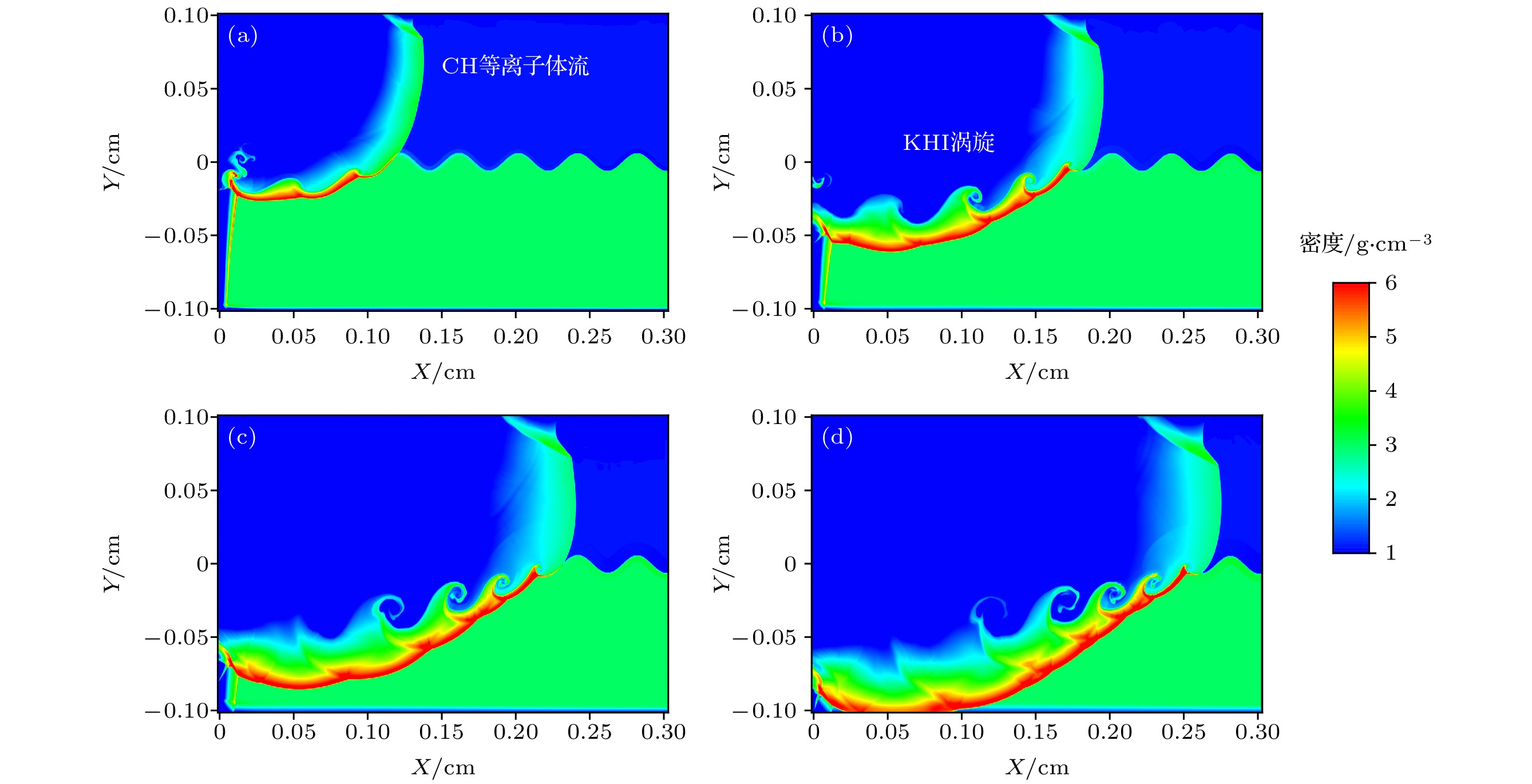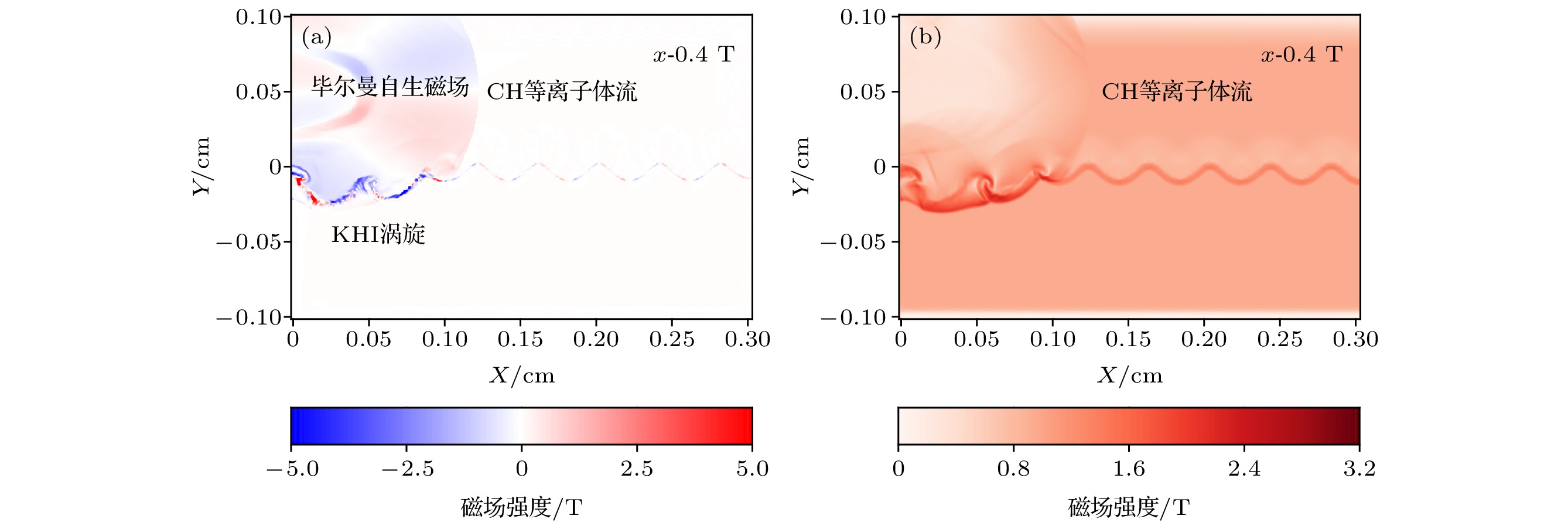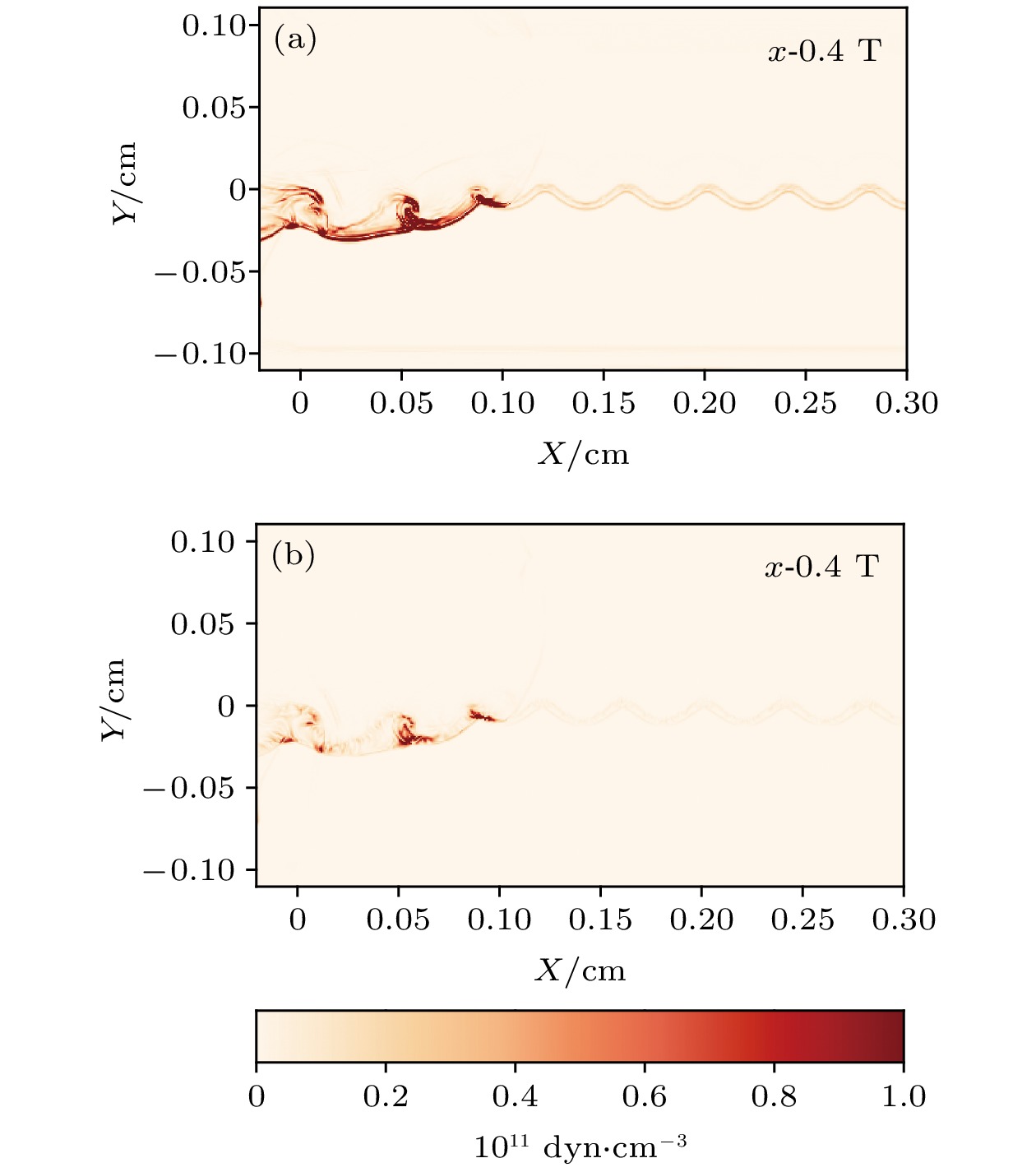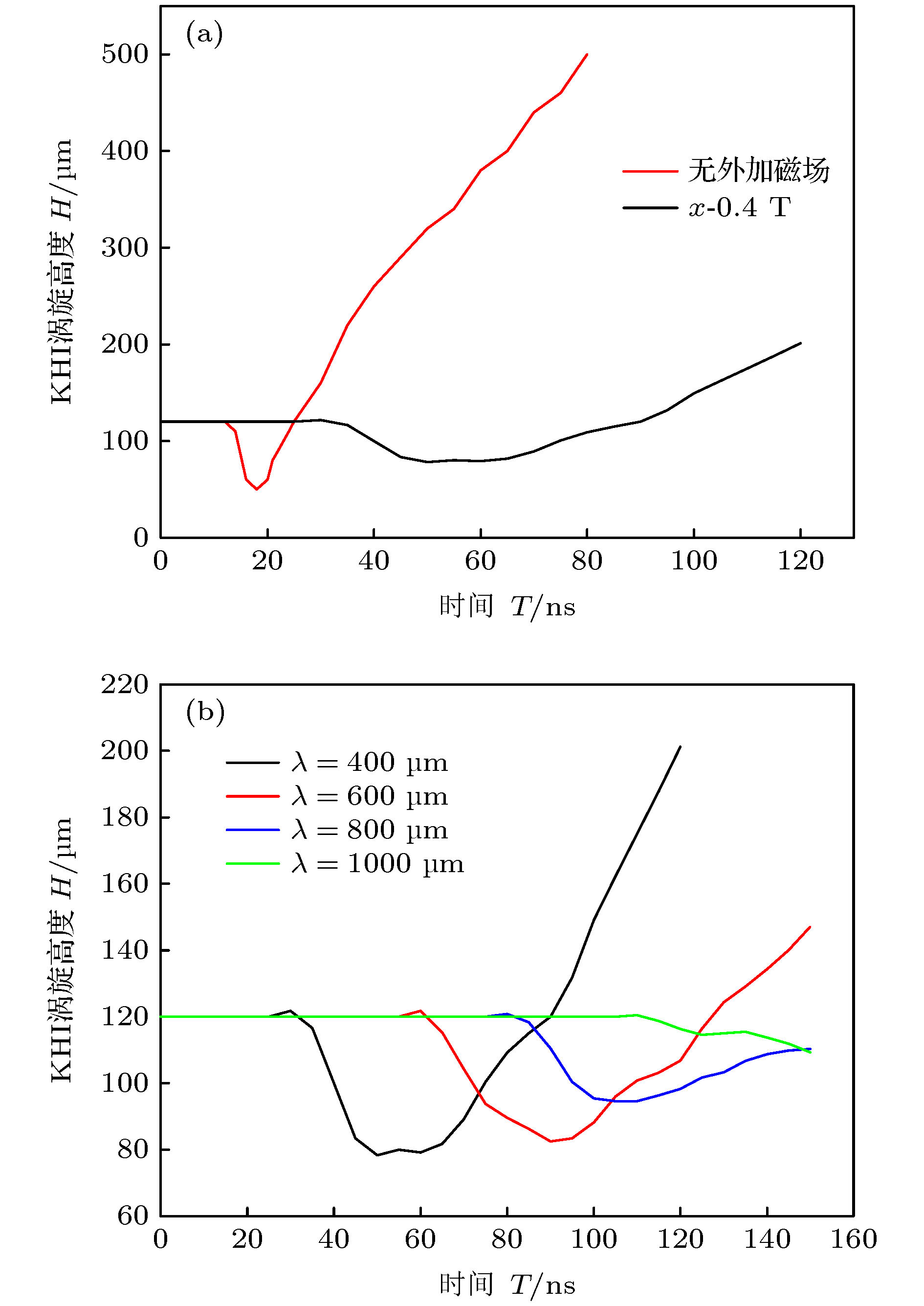-
Kelvin-Helmholtz instability is the basic physical process of fluids and plasmas. It is widely present in natural, astrophysical, and high energy density physical phenomena. With the construction of strong laser facilities, the research on high energy density physics has gained new impetus. However, in recent years the magnetized Kelvin-Helmholtz instability was rarely studied experimentally. In this work, we propose a new experimental scheme, in which a long-pulsed nanosecond laser beam is generated by a domestic starlight III laser facility. The whole target consists of two parts: the upper part that is the CH modulation layer with lower density, and the lower part that is the Al modulation layer with higher density. The laser beam is injected from one side of the CH modulation layer and generates a CH plasma outflow at the back of the target. During the transmission of the CH plasma outflow, the Al modulation layer is radiated and ionized, which makes the Al modulation layer generate an Al plasma outflow. The interaction between the Al plasma outflow and the CH plasma outflow produces a velocity shear layer, and then Kelvin-Helmholtz instability will gradually form near the Al modulation layer. In this paper, the open-source FLASH simulation program is used to conduct a two-dimensional numerical simulation of the Kelvin-Helmholtz instability generated by the laser-driven modulation target. We use the FLASH code, which is an adaptive mesh refinement program, developed by the Flash Center at the University of Chicago, and is well-known in astrophysics and space geophysics, to create a reference to the magnetohydrodynamic solution in our experiment. At present, this code introduces a complete high-energy-density physical modeling module, which is especially suitable for simulating intense laser ablation experiments. The equation of state and opacity tables of targets are based on the IONMIX4 database. The evolution of Kelvin-Helmholtz vortices, separately, in the Biermann self-generated magnetic field, the external magnetic field, and no magnetic field are investigated and compared with each other. It is found that the self-generated magnetic field hardly changes the morphology of the Kelvin-Helmholtz vortex during the evolution of Kelvin-Helmholtz instability. The external magnetic field parallel to the fluid direction can stabilize the shear flow. The magnetic field mainly stabilizes the long wave disturbance. The study results in this work can provide theoretical guidance for the next step of the Kelvin-Helmholtz experiment under a strong magnetic environment in the high energy density laser facility.
-
Keywords:
- magnetic field /
- Kelvin-Helmholtz instability /
- high energy density /
- laser
[1] Li X, Zhang J, Yang S, Hou Y, Erdelyi R 2018 Sci. Rep. 8 8136
 Google Scholar
Google Scholar
[2] Steinbusch B, Gibbon P, Sydora R D 2016 Phys. Plasmas 23 052119
 Google Scholar
Google Scholar
[3] Price D J, Rosswog S 2006 Science 312 719
 Google Scholar
Google Scholar
[4] Kiuchi K, Cerdá-Durán P, Kyutoku K, Sekiguchi Y, Shibata M 2015 Phys. Rev. D 92 124034
 Google Scholar
Google Scholar
[5] Foullon C, Verwichte E, Nakariakov V M, Nykyri K, Farrugia C J 2011 Astrophys. J. Lett. 729 L8
 Google Scholar
Google Scholar
[6] Li X, Narayan R 2004 Astrophys. J. 601 414
 Google Scholar
Google Scholar
[7] Yuan D, Shen Y, Liu Y, Li H, Feng X, Keppens R 2019 Astrophys. J. Lett. 884 L51
 Google Scholar
Google Scholar
[8] Ershkovich A I 1980 Space Sci. Rev. 25 3
 Google Scholar
Google Scholar
[9] Dittrich T R, Hammel B A, Keane C J, McEachern R, Turner R E, Haan S W, Suter L J 1994 Phys. Rev. Lett. 73 2324
 Google Scholar
Google Scholar
[10] Hammel B A, Haan S W, Clark D S, Edwards M J, Langer S H, Marinak M M, Patel M V, Salmonson J D, Scott H A 2010 High Energy Dens. Phys. 6 171
 Google Scholar
Google Scholar
[11] Clark D S, Haan S W, Cook A W, Edwards M J, Hammel B A, Koning J M, Marinak M M 2011 Phys. Plasmas 18 082701
 Google Scholar
Google Scholar
[12] Zhou Y, Remington B A, Robey H F, Cook A W, Glendinning S G, Dimits A, Buckingham A C, Zimmerman G B, Burke E W, Peyser T A, Cabot W, Eliason D 2003 Phys. Plasmas 10 1883
 Google Scholar
Google Scholar
[13] Zhou Y 2017 Phys. Rep. 720-722 1
 Google Scholar
Google Scholar
[14] Chandrasekhar S 1961 Hydrodynamic and Hydromagnetic Stability (Oxford: Clarendon Press) pp481−512
[15] 范征锋, 叶文华, 孙彦乾, 郑炳松, 李英骏, 王立锋 2009 58 6381
 Google Scholar
Google Scholar
Fan Z F, Ye W H, Sun Y Q, Zheng B S, Li Y J, Wang L F 2009 Acta Phys. Sin. 58 6381
 Google Scholar
Google Scholar
[16] 范征锋, 叶文华, 李英骏, 王立锋 2009 58 4787
 Google Scholar
Google Scholar
Fan Z F, Ye W H, Li Y J, Wang L F 2009 Acta Phys. Sin. 58 4787
 Google Scholar
Google Scholar
[17] Mak J, Griffiths S D, Hughes D W 2017 Phys. Rev. Fluid 2 113701
 Google Scholar
Google Scholar
[18] Liu Y, Chen Z H, Zhang H H, Lin Z Y 2018 Phys. Fluids 30 044102
 Google Scholar
Google Scholar
[19] Harding E C, Hansen J F, Hurricane O A, Drake R P, Robey H F, Kuranz C, Gillespie R S 2009 Phys. Rev. Lett. 103 045005
 Google Scholar
Google Scholar
[20] Wan W C, Malamud G, Shimony A, Stefano C A, Trantham M R, Klein S R, Drake R P 2015 Phys. Rev. Lett. 115 145001
 Google Scholar
Google Scholar
[21] Wan W C, Malamud G, Shimony A, Di Stefano C A, Trantham M R, Klein S R, Kuranz C C 2017 Phys. Plasmas 24 055705
 Google Scholar
Google Scholar
[22] Sun W, Zhong J, Zhang S, Tong B W, Wang L F, Zhao K G, Liu J Y, Han B, Zhu B J, Yuan D W, Yuan X X, Zhang Z, Li Y T, Zhang Q, Peng J M, Wang J Z, Ping Y L, Xing C Q, Wei H G, Liang G Y, Xie Z Y, Wang C, Zhao G, Zhang J 2019 High Energy Dens. Phys. 31 47
 Google Scholar
Google Scholar
[23] Fryxell B, Olson K, Ricker P, Timmes F X, Zingale M, Lamb D Q, Macneice P, Rosner R, Truran J W, Tufo H M 2000 Astrophys. J. Suppl. Ser. 131 273
 Google Scholar
Google Scholar
[24] Macfarlane J J 1989 Comput. Phys. Commun. 56 259
 Google Scholar
Google Scholar
[25] Rutter E M, Grosskopf M J, Malamud G, Kuranz C C, Harding E C, Keiter P A, Drake R P 2013 High Energy Dens. Phys. 9 148
 Google Scholar
Google Scholar
[26] Farmer W A, Koning J M, Strozzi D J, Hinkel D E, Berzak Hopkins L F, Jones O S, Rosen M D 2017 Phys. Plasmas 24 052703
 Google Scholar
Google Scholar
[27] Woolsey N C, Courtois C, Dendy R O 2004 Plasma Phys. Controlled Fusion 46 B397
 Google Scholar
Google Scholar
-
图 4 (a) 考虑毕尔曼自生磁场, 在120 ns时毕尔曼自生磁场强度的分布情况; (b)忽略毕尔曼自生磁场, 在120 ns时外加磁场在模拟平面的分布情况
Figure 4. (a) Considering the Biermann self-generated magnetic field, the distribution of the Bierman self-generated magnetic field strength at 120 ns; (b) ignoring the Bierman self-generated magnetic field, the distribution of the applied magnetic field in the simulated plane at 120 ns.
-
[1] Li X, Zhang J, Yang S, Hou Y, Erdelyi R 2018 Sci. Rep. 8 8136
 Google Scholar
Google Scholar
[2] Steinbusch B, Gibbon P, Sydora R D 2016 Phys. Plasmas 23 052119
 Google Scholar
Google Scholar
[3] Price D J, Rosswog S 2006 Science 312 719
 Google Scholar
Google Scholar
[4] Kiuchi K, Cerdá-Durán P, Kyutoku K, Sekiguchi Y, Shibata M 2015 Phys. Rev. D 92 124034
 Google Scholar
Google Scholar
[5] Foullon C, Verwichte E, Nakariakov V M, Nykyri K, Farrugia C J 2011 Astrophys. J. Lett. 729 L8
 Google Scholar
Google Scholar
[6] Li X, Narayan R 2004 Astrophys. J. 601 414
 Google Scholar
Google Scholar
[7] Yuan D, Shen Y, Liu Y, Li H, Feng X, Keppens R 2019 Astrophys. J. Lett. 884 L51
 Google Scholar
Google Scholar
[8] Ershkovich A I 1980 Space Sci. Rev. 25 3
 Google Scholar
Google Scholar
[9] Dittrich T R, Hammel B A, Keane C J, McEachern R, Turner R E, Haan S W, Suter L J 1994 Phys. Rev. Lett. 73 2324
 Google Scholar
Google Scholar
[10] Hammel B A, Haan S W, Clark D S, Edwards M J, Langer S H, Marinak M M, Patel M V, Salmonson J D, Scott H A 2010 High Energy Dens. Phys. 6 171
 Google Scholar
Google Scholar
[11] Clark D S, Haan S W, Cook A W, Edwards M J, Hammel B A, Koning J M, Marinak M M 2011 Phys. Plasmas 18 082701
 Google Scholar
Google Scholar
[12] Zhou Y, Remington B A, Robey H F, Cook A W, Glendinning S G, Dimits A, Buckingham A C, Zimmerman G B, Burke E W, Peyser T A, Cabot W, Eliason D 2003 Phys. Plasmas 10 1883
 Google Scholar
Google Scholar
[13] Zhou Y 2017 Phys. Rep. 720-722 1
 Google Scholar
Google Scholar
[14] Chandrasekhar S 1961 Hydrodynamic and Hydromagnetic Stability (Oxford: Clarendon Press) pp481−512
[15] 范征锋, 叶文华, 孙彦乾, 郑炳松, 李英骏, 王立锋 2009 58 6381
 Google Scholar
Google Scholar
Fan Z F, Ye W H, Sun Y Q, Zheng B S, Li Y J, Wang L F 2009 Acta Phys. Sin. 58 6381
 Google Scholar
Google Scholar
[16] 范征锋, 叶文华, 李英骏, 王立锋 2009 58 4787
 Google Scholar
Google Scholar
Fan Z F, Ye W H, Li Y J, Wang L F 2009 Acta Phys. Sin. 58 4787
 Google Scholar
Google Scholar
[17] Mak J, Griffiths S D, Hughes D W 2017 Phys. Rev. Fluid 2 113701
 Google Scholar
Google Scholar
[18] Liu Y, Chen Z H, Zhang H H, Lin Z Y 2018 Phys. Fluids 30 044102
 Google Scholar
Google Scholar
[19] Harding E C, Hansen J F, Hurricane O A, Drake R P, Robey H F, Kuranz C, Gillespie R S 2009 Phys. Rev. Lett. 103 045005
 Google Scholar
Google Scholar
[20] Wan W C, Malamud G, Shimony A, Stefano C A, Trantham M R, Klein S R, Drake R P 2015 Phys. Rev. Lett. 115 145001
 Google Scholar
Google Scholar
[21] Wan W C, Malamud G, Shimony A, Di Stefano C A, Trantham M R, Klein S R, Kuranz C C 2017 Phys. Plasmas 24 055705
 Google Scholar
Google Scholar
[22] Sun W, Zhong J, Zhang S, Tong B W, Wang L F, Zhao K G, Liu J Y, Han B, Zhu B J, Yuan D W, Yuan X X, Zhang Z, Li Y T, Zhang Q, Peng J M, Wang J Z, Ping Y L, Xing C Q, Wei H G, Liang G Y, Xie Z Y, Wang C, Zhao G, Zhang J 2019 High Energy Dens. Phys. 31 47
 Google Scholar
Google Scholar
[23] Fryxell B, Olson K, Ricker P, Timmes F X, Zingale M, Lamb D Q, Macneice P, Rosner R, Truran J W, Tufo H M 2000 Astrophys. J. Suppl. Ser. 131 273
 Google Scholar
Google Scholar
[24] Macfarlane J J 1989 Comput. Phys. Commun. 56 259
 Google Scholar
Google Scholar
[25] Rutter E M, Grosskopf M J, Malamud G, Kuranz C C, Harding E C, Keiter P A, Drake R P 2013 High Energy Dens. Phys. 9 148
 Google Scholar
Google Scholar
[26] Farmer W A, Koning J M, Strozzi D J, Hinkel D E, Berzak Hopkins L F, Jones O S, Rosen M D 2017 Phys. Plasmas 24 052703
 Google Scholar
Google Scholar
[27] Woolsey N C, Courtois C, Dendy R O 2004 Plasma Phys. Controlled Fusion 46 B397
 Google Scholar
Google Scholar
Catalog
Metrics
- Abstract views: 7990
- PDF Downloads: 113
- Cited By: 0















 DownLoad:
DownLoad:






